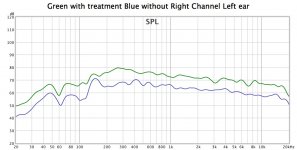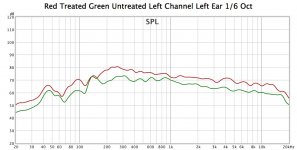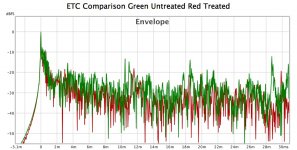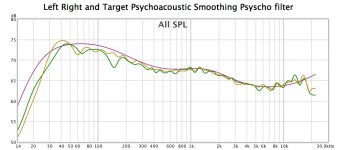Thanks, me too, it was kind of forced on me by the fabric shop not having enough of one colour to do everything the same but I quite like it. When the walls are painted and the awful green carpet replaced it will look much better againI like your several shades of grey decorating scheme.
They free stand quite nicely and are better balanced than I thought they would be. I went with the cheapest being mdf, three sheets for all the panels cost me less than one would have been if I used pine. The fabric was the most expensive part!like those panels are deep enough to stand up on their own, which is convenient.
The nice thing about line arrays is the only treatment you need is vertical panels. No hanging things from the ceiling or trying to pad the floor.
The last couple of panels I built were made from 1"x8" fingerjoint pine boards from Home Depot, with 6" thick x 23" paper backed fiberglass stapled inside the frame to close the back with paper. Really inexpensive and quick construction.
Can't wait to see some measurements...
New measurements taken including a Jriver loopback test of the system function I have been listening to. Not much time as yet to look and compare, main dips are still there but overall looks better. Will post when I have time to look a bit deeper
Here's a couple of comparison graphs showing the differences between treated and untreated, frequency graphs smoothed at 1/6 oct to try and show the overall trend. Less bump and dip easier to correct below 1K, above shows more dips probably because they aren't being filled in by reflections.
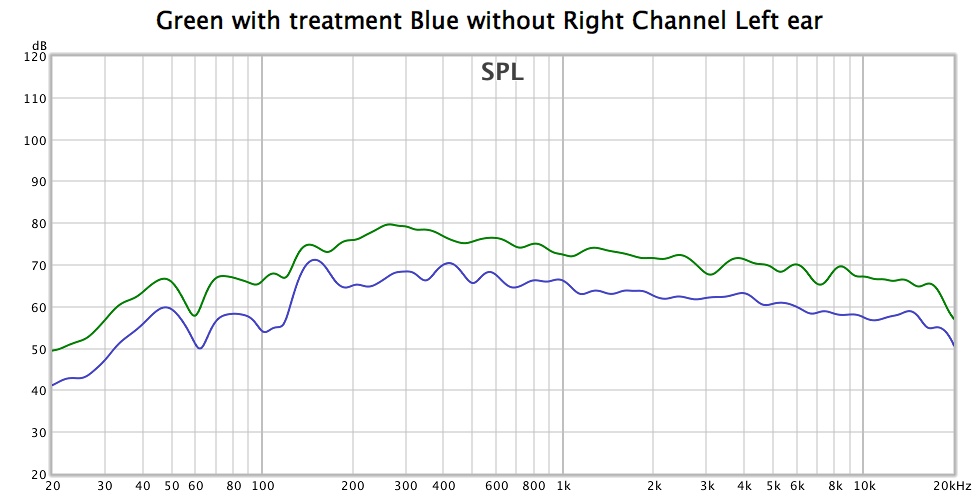
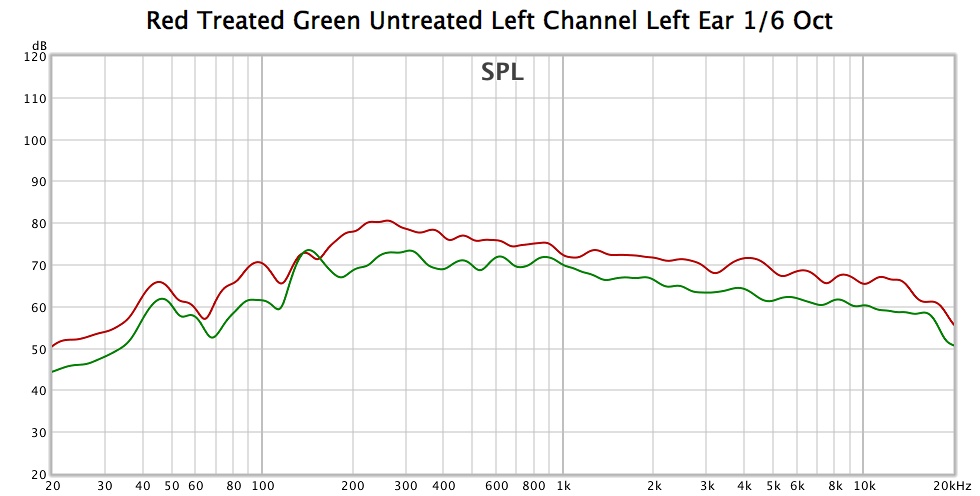
Not easy to read this but you can see the red is lower in level and less restless overall
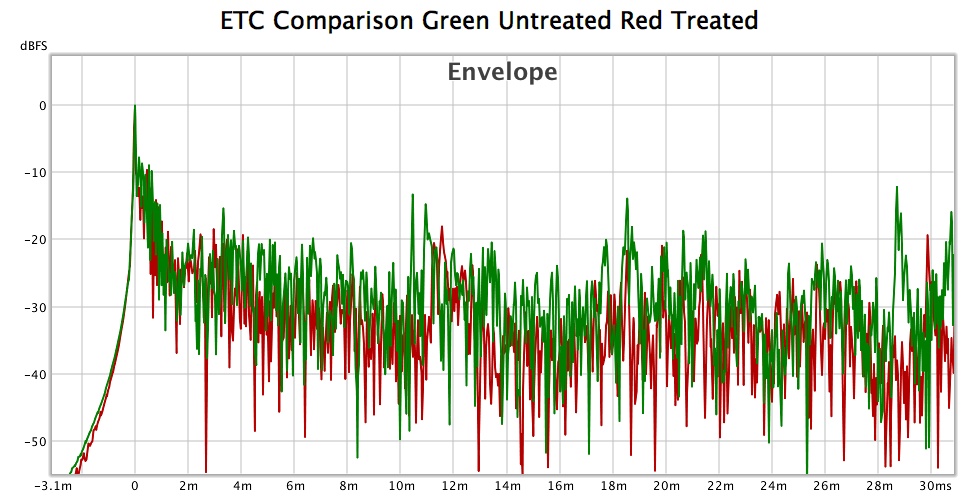
Not easy to read this but you can see the red is lower in level and less restless overall
Attachments
What do you hear, as a difference between the two in listening?
It is obvious there is a definitive improvement in direct vs indirect sound.
Does it get "more quiet" in comparison? Less wild? I think this gives you an excellent base to improve upon with further processing. Most reflections are down below the -20 dB (which was my initial goal) and gives an opportunity to play with ambience addons later on.
First get the balance right between left and right channel. Is this a Stereo or mono channel? If this is mono, a Stereo sweep will improve it even further!
It is obvious there is a definitive improvement in direct vs indirect sound.
Does it get "more quiet" in comparison? Less wild? I think this gives you an excellent base to improve upon with further processing. Most reflections are down below the -20 dB (which was my initial goal) and gives an opportunity to play with ambience addons later on.
First get the balance right between left and right channel. Is this a Stereo or mono channel? If this is mono, a Stereo sweep will improve it even further!
Hmm, not easy to quantify that, due to the difficulty of moving the panels in and out there was no direct comparison. I notice that some of the things I was trying to fix unsuccessfully with EQ were better with the panels in and no longer annoyed me.What do you hear, as a difference between the two in listening?
Quiet yes I turned the volume up about 3dB from the level I had chosen before, Less wild, yes more refined. I can tell that something has gone too and I think the ambience speakers are important to try. I have been re reading a few papers and articles where good listening acoustics are discussed. Even though there is no concrete agreement between the different experts, I take away from it that removing early reflections through absorption and adding later ones through electronic or acoustic means is a practical way to get the best of both worlds in a less than ideal space.Does it get "more quiet" in comparison? Less wild? I think this gives you an excellent base to improve upon with further processing. Most reflections are down below the -20 dB (which was my initial goal) and gives an opportunity to play with ambience addons later on.
First get the balance right between left and right channel. Is this a Stereo or mono channel? If this is mono, a Stereo sweep will improve it even further!
Those graphs were mono top one right channel only, bottom left channel only.
I need to do some more work to check the relative left right channel balance in level to see if a small tweek is needed to get them the same.
Ear position measurements didn't really work again on the updated correction filter, I can't find a place where I want to put my head I keep wanting to move it. A four position average gets rid of that, it surprises me more this time as the difference between the two is not much.
I've been tweaking my customized DRC scheme a bit lately; any chance you wouldn't mind ..... auditioning a filter or two for me?
I have been testing out your new psycho filter to see what it does. I quite like it, very different to what I've been doing before as the windows are very short and using quite different exponents. I like the way it is not filling in the dips, which parameters are responsible for that part of it?
I had trouble on the first run getting the channels even. Round two with better tuned pre EQ is looking better, I haven't listened to this one yet but it looks much better
Attachments
Untreated looks better. Sounds? The blue ans green traces, why would anyone want to improve these - looks smashing. My experience of "damping /absorption" is that it sucks the life out of the music. Every time I tried, I lived with for a while but in the end always preferred the none damped. YMMV.
//
//
To me treated looks better below 600Hz less resonances being exited. The plots are smoothed with a fairly low scale value (used to show the general trends). Sound of a raw array with no EQ is not great, but if subs were being added to those plots they would need much less EQ.
There is something that has been lost from the damping panels which is why I want to try the ambient additions to see if I can get that back but not lose the clarity and less resonant low end that came from the damping.
They sound more like big headphones right now which isn't to everyones liking.
Wesayso has said much the same before and considers the ambient setup important to the overall result. I have tried quite a few different approaches but I always find myself tending to agree with him in the end
There is something that has been lost from the damping panels which is why I want to try the ambient additions to see if I can get that back but not lose the clarity and less resonant low end that came from the damping.
They sound more like big headphones right now which isn't to everyones liking.
Wesayso has said much the same before and considers the ambient setup important to the overall result. I have tried quite a few different approaches but I always find myself tending to agree with him in the end
It may not be easy to find the right mix right away, but I went through the same process.
Even though the damping panels can clear up the sound, I started missing some "energy" for lack of a better explanation. Introducing the ambient channels gave that back to me, this time fully adjustable to taste.
Contrary to what most think, you don't hear the ambient channels (at least you're not supposed to hear them if everything works as planned). It's what they do for the imaging/balance and overall feel for the mains that makes it worth it. Together with mid/side processing it's one of the key ingredients for me.
The reason for me to try it came from reading something on the diymobileaudio forums long ago. Posted by werewolf (or his pseudonym lycan), the author of the excellent thread on infinite line array theory.
Even though the damping panels can clear up the sound, I started missing some "energy" for lack of a better explanation. Introducing the ambient channels gave that back to me, this time fully adjustable to taste.
Contrary to what most think, you don't hear the ambient channels (at least you're not supposed to hear them if everything works as planned). It's what they do for the imaging/balance and overall feel for the mains that makes it worth it. Together with mid/side processing it's one of the key ingredients for me.
The reason for me to try it came from reading something on the diymobileaudio forums long ago. Posted by werewolf (or his pseudonym lycan), the author of the excellent thread on infinite line array theory.
I have been testing out your new psycho filter to see what it does...
fluid,
Thanks for checking it out, and glad to hear there is some potential there. I think it could make a nice compliment to your acoustic treatment.
In the EQ stage, the dips are not weighted nearly as much as the peaks; this is simply the behavior of the psychoacoustic target stage algorithm, which in this case is what's generating the EQ curve. What I did adjust regarding the PT stage, however, is its resolution. It's Bark scale, so its resolution in the lower treble range basically matches that of the prefiltered response, but the Q-factor decreases above and (especially) below this range.
For channel balancing, try convolving "ImpulseResponsePrefiltered.wav" with "PsychoFilter.wav", and look at the L/R peak levels of the resulting response in Audacity.
BTW, Re your target: I recently created a target response file named (of all things) "PsychoTarget.txt", which matches the general trend I see with my anechoically corrected speakers measured at the listening position. It's similar to a linear tilt but the slope changes by a factor of 1.73X (root 3) per octave rather than 2X (root 4). Your target reminds me of that response but with "loudness compensation" applied...
Last edited:
I will try the JBL LSR 305MKII's that I have first as they are a plug an play solution. I had a problem measuring the JBL's the last time I tried. One speaker was fine but the other would shutdown at somewhere around 6k making it hard to measure and apply the appropriate correction. I'll try again and see what happens. A TC9 would probably work too given not much spl is being asked of it. Once i've settled on a frequency and spl target I might make something separate.What will you use for ambient speakers and where placed? Good use for just a few more tc9s, given spl requirements?
As for position somewhere behind me and firing to the sides, bit limited on placement options due to room shape so suck it and see.
No point dismissing anything until you've tried itfluid,
Thanks for checking it out, and glad to hear there is some potential there. I think it could make a nice compliment to your acoustic treatment.
I notice you have DLMinGain set at 0.01 which a quite a lot lower than I have used, what's your take on that parameter, I don't find the explanation in the documentation to make it clear.
The windowing and resolution might work better for me if I changed these some testing to be done there.In the EQ stage, the dips are not weighted nearly as much as the peaks; this is simply the behavior of the psychoacoustic target stage algorithm, which in this case is what's generating the EQ curve. What I did adjust regarding the PT stage, however, is its resolution. It's Bark scale, so its resolution in the lower treble range basically matches that of the prefiltered response, but the Q-factor decreases above and (especially) below this range.
According to that I need to reduce the right channel by 1.189dB I'll try it and see what happens.For channel balancing, try convolving "ImpulseResponsePrefiltered.wav" with "PsychoFilter.wav", and look at the L/R peak levels of the resulting response in Audacity.
Wesayso gave that to me and so far it is proving to be good. Maybe a little too much lower mid but that is quite hard to take out without losing something too. The best target I used before had a curve in the downtilt in the mid frequencies and that was consistently preferred to straight lines. The 3k to 6k scoop I like. I took it out with EQ and then used a graphic EQ to get my preferred sound and when I checked all I did was EQ the scoop back inBTW, Re your target: I recently created a target response file named (of all things) "PsychoTarget.txt", which matches the general trend I see with my anechoically corrected speakers measured at the listening position. It's similar to a linear tilt but the slope changes by a factor of 1.73X (root 3) per octave rather than 2X (root 4). Your target reminds me of that response but with "loudness compensation" applied...
Having not experimented with DLMinGain; my take on it is that lower values (default value seems pretty low) are not likely to impact the prefiltered response.
As for experimenting with prefitering/EQ resolution: I think I may have originally wanted you to audition something like a 4.3 cycle prefilter with 1/3 oct EQ. If you want something similar to but stronger than the current config, you could try a 4.3 cycle prefiltering stage (19000/19 lower/upper window lengths) with ERB resolution EQ stage(PTBandWidth = -2). This may reduce your need for pre-eq, but likely at the expense of increased filter gain.
As for experimenting with prefitering/EQ resolution: I think I may have originally wanted you to audition something like a 4.3 cycle prefilter with 1/3 oct EQ. If you want something similar to but stronger than the current config, you could try a 4.3 cycle prefiltering stage (19000/19 lower/upper window lengths) with ERB resolution EQ stage(PTBandWidth = -2). This may reduce your need for pre-eq, but likely at the expense of increased filter gain.
Last edited:
I'll try some different windows and resolutions to see what I think. I have been listening to Psycho Filter take 2 with the the right channel 1.2dB lower (response shown above in the comparison graph without the gain adjustment) the better channel matching in level and frequency is an obvious improvement and I have been really enjoying listening to it. I do remember enjoying music was one of my original goals before all the building and tweaking started 
I can't find much to complain about on first listen. Longer windows in the bass or some phase tweaks might help.
I can't find much to complain about on first listen. Longer windows in the bass or some phase tweaks might help.
Very glad to hear it, fluid. I was hoping this would be effective for others, so this is very encouraging. And I think we can agree that having "cleared the way" for musical experiences is a good indication of effectiveness. 
I think effectively reaching the next level of performance probably involves (in addition to increased complexity of the procedure, possible filter artifacts, and a possible reduction of that fuzzy zen feeling, ) flattening the phase response seen in the predicted correction. This is how you "fix the dips" without actually boosting. I've done it - it's a pain, but it does make the low end sound like my HD580s. In your system, it may not make as much of a difference. Personally, all things considered, I'm happy right now with the minimal approach.
) flattening the phase response seen in the predicted correction. This is how you "fix the dips" without actually boosting. I've done it - it's a pain, but it does make the low end sound like my HD580s. In your system, it may not make as much of a difference. Personally, all things considered, I'm happy right now with the minimal approach.
Anyway, good luck and thanks for the report.
edit: I keep forgetting to ask: did you use a single point measurement for this?
I think effectively reaching the next level of performance probably involves (in addition to increased complexity of the procedure, possible filter artifacts, and a possible reduction of that fuzzy zen feeling,
Anyway, good luck and thanks for the report.
edit: I keep forgetting to ask: did you use a single point measurement for this?
Last edited:
I was surprised how much I did enjoy it and how much difference came from using different preEQ, I just kept wanting to try different material, some previous filters have lasted two songs at most. I tried the Mid Side EQ again and that was quite successful.Very glad to hear it, fluid. I was hoping this would be effective for others, so this is very encouraging. And I think we can agree that having "cleared the way" for musical experiences is a good indication of effectiveness.
Could you explain more what you are thinking here? Do you have any screenshots of the phase manipulation? I would be interested because it is very easy to overdo that, an example of something successful would be helpful.I think effectively reaching the next level of performance probably involves (in addition to increased complexity of the procedure, possible filter artifacts, and a possible reduction of that fuzzy zen feeling,) flattening the phase response seen in the predicted correction. This is how you "fix the dips" without actually boosting. I've done it - it's a pain, but it does make the low end sound like my HD580s.
4 point average on this one, I have got v2 at ear positions but I haven't tried it yet. I will try a more traditional single point sweet spot "between the ears" measurement next time the mic is out.edit: I keep forgetting to ask: did you use a single point measurement for this?
I listened to the 4 point average all around the room and in the rooms adjacent and the sound was really quite good everywhere, if nothing else a good option for background listening.
I'm guessing that the differences due to pre-EQ are the result of the Pre-EQ having more low freq resolution than the (Bark scale) EQ.
Regarding phase correction: there is probably a better way to do this, but basically I loaded the (flat target version of the) predicted correction ("ImpulseResponsePrefiltered.wav" convolved with "PsychoFilter.wav") into REW, smoothed 1/3 oct, exported as .txt, zeroed out amplitude (freq) values, inverted phase values, used as a target response file with PSFilterType = L applied to a clean impulse, and implemented in a 2nd convolver instance. Not my idea of a good time .
.
Great news about the good sound from everywhere; this has been my experience as well. Please let me know how the single point works out.
Regarding phase correction: there is probably a better way to do this, but basically I loaded the (flat target version of the) predicted correction ("ImpulseResponsePrefiltered.wav" convolved with "PsychoFilter.wav") into REW, smoothed 1/3 oct, exported as .txt, zeroed out amplitude (freq) values, inverted phase values, used as a target response file with PSFilterType = L applied to a clean impulse, and implemented in a 2nd convolver instance. Not my idea of a good time
Great news about the good sound from everywhere; this has been my experience as well. Please let me know how the single point works out.
The biggest difference was in the high frequencies and match between the channels, a better match going into DRC always makes the end result better for me. I removed more of the 45Hz room mode too as that seemed to be throwing things off.
Have you put the "PsychoTarget.txt" anywhere I looked in your updated downloads but couldn't see it. I would like to have look.
Have you put the "PsychoTarget.txt" anywhere I looked in your updated downloads but couldn't see it. I would like to have look.
- Home
- Loudspeakers
- Full Range
- Full Range TC9 Line Array CNC Cabinet
